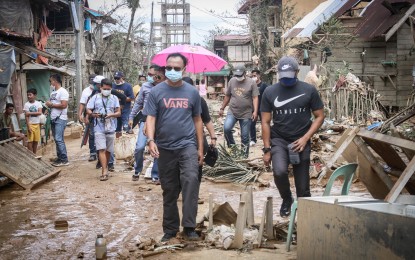
MUDDY STREET. Eastern Samar Governor Ben Evardone (left) and other local officials walk on a muddy street in Jipapad, Eastern Samar in this May 16, 2020 photo or two days after the typhoon that brought heavy flooding. The Eastern Samar provincial government has placed on Tuesday (May 19, 2020) the nine towns in the province under state of calamity due to damages caused by Typhoon Ambo. (Photo courtesy of Eastern Samar Governor Ben Evardone)
TACLOBAN CITY – The Eastern Samar provincial government has placed on Tuesday the nine towns in the province under state of calamity due to destructions caused by Typhoon Ambo.
These towns are Sulat, Taft, Can-avid, Dolores, Maslog, Oras, San Policarpo, Arteche, and Jipapad where flash floods destroyed houses and livelihoods of thousands of residents.
Provincial Disaster Risk Reduction and Management Office (PDRRMO) chief Ma. Josefina Titong highly recommended on May 15 the declaration of state of calamity due to the extent of the damage brought about the typhoon.
Based on the initial report from the PDRRMO, Ambo’s damage to agriculture has already reached PHP912.6 million. About PHP41 million worth of public infrastructure was destroyed by strong winds.
The typhoon has displaced 34,235 families in the nine towns with half of them moved to higher grounds during the height of the typhoon.
Thousands of houses have been destroyed by fierce winds, flooding, and violent waves.
The PDRRMO reported that at least three people died during the typhoon — one in San Policarpo town who was hit by shattered glasses causing loss of blood and two in Oras town who suffered from heart attack.
With the approval of the declaration of state of calamity, the provincial government can now use its calamity fund to assist affected residents.
Governor Ben Evardone said on Tuesday they have already asked assistance from national government agencies like the National Housing Authority, Department of Social Welfare and Development, Department of Labor and Employment and the Department of Public Works and Highways.
Evardone said they have to seek support from the central government since their fund is already depleted due to massive spending related to coronavirus disease 2019 (Covid-19) pandemic response.
Aside from providing post-disaster needs of affected families, the provincial government has to prioritize the immediate repair of Covid-19 isolation facilities damaged by the typhoon.
The province has more than 600 bed-capacity isolation facilities in different towns with nearly 400 beds have been destroyed.
“We have to repair the isolation facilities in each town because other towns will not allow that suspected virus carrier from a neighboring town will be placed in their isolation area,” Evardone said.
In San Policarpo town, Mayor Thelma Nicart said the local government has approved at least PHP4 million budget for cash assistance distribution to their residents.
“Each household will receive PHP1,000 cash from the local government. This could help people rebuild their houses,” Nicart said.
In Jipapad town, Mayor Benjamin Ver said all people in their town need food, safe drinking water, clothes, and medicine.
“Ambo was the strongest typhoon that hit our municipality with a flood that was 20-feet high. Right now, we are isolated here in Jipapad because the temporary bridge that connects the town center to the main road collapsed,” Ver said.
Arteche town Mayor Roland Boei Evardone said they have to throw away more than 100 prepositioned food packs after being soaked in floodwater for hours.
“Communication is a problem. We have to travel to Dolores town for about two hours to send a message and do calls to inform our loved ones that we are safe,” the mayor said.
As of Monday night, the Eastern Samar Electric Cooperative has already restored electricity in the main power lines in Can-avid and Dolores towns after the typhoon toppled hundreds of electric posts.
On May 14, the typhoon brought violent winds and heavy to intense rains over the northern portion of Samar and the southern portion of Northern Samar, according to the Philippine Atmospheric, Geophysical and Astronomical Services Administration.
The typhoon packed maximum sustained winds of up to 155 kilometers per hour (kph) and gustiness of up to 255 kph. (PNA)
